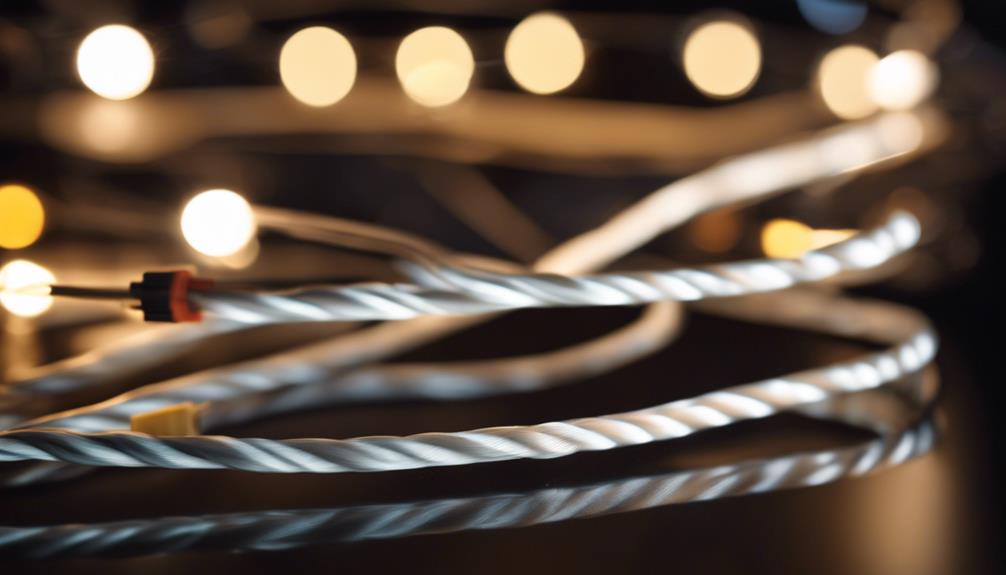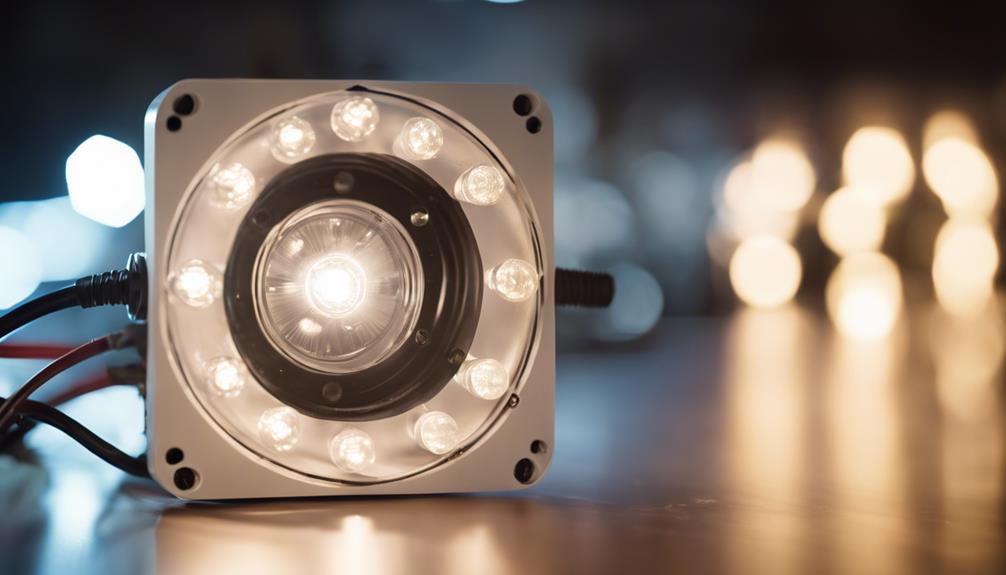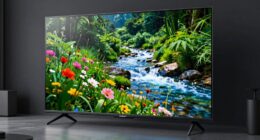Inadequate voltage management can cause harm to LED lights, impacting their performance and lifespan. To avoid potential damage, it is essential to consider factors such as voltage sensitivity, resistors, heat dissipation, and cable thickness. Using thicker cables and placing the power supply strategically can minimize the risk of voltage drop and protect the performance of the LED lights. Consulting with a professional for guidance on LED selection and installation can help mitigate risks, ensuring optimal brightness and longevity. By recognizing and addressing these risks proactively, one can effectively safeguard their investment in LED lighting. For more information on effectively managing risks associated with LEDs, please refer to the following link.
Key Takeaways
- Applying voltage below minimum forward level isn't harmful to LEDs.
- Thicker cables reduce voltage drop and protect LEDs.
- Strategic power supply points maintain consistent brightness.
- Voltage regulation devices enhance stability and performance.
- Seek expert advice to optimize LED performance and longevity.
Factors Affecting LED Light Damage
When managing the risks of low voltage on LED lights, understanding the factors that can lead to LED light damage is essential. LEDs are sensitive to voltage levels, and applying a voltage below the LED's minimum forward voltage typically doesn't harm the LED to a great extent. However, as LEDs heat up, they exhibit a negative temperature coefficient, allowing more current to flow through them, which can pose risks if not properly regulated. LEDs are often connected with resistors in series or current regulating circuits to ensure peak performance and prevent damage.
One critical factor affecting LED light damage is heat dissipation. Effective heat dissipation is vital for maintaining LED longevity and performance. Additionally, uneven current distribution, often caused by unmatched LEDs in a circuit, can lead to overheating and impact the overall performance of the LEDs. Understanding these risks and implementing proper current regulating circuits are essential steps in mitigating the potential damage that low voltage can pose to LED lights.
Calculating Cable Gauge and Length

Calculating the cable gauge and length is essential in reducing voltage drop in LED lighting systems. Thicker cables are recommended for long installations with high-power LEDs to maintain voltage stability.
Strategic placement of power supply points can help counteract voltage drop over extended distances, ensuring peak LED performance.
Cable Gauge Importance
Thicker cables play an essential role in reducing voltage drop over extended distances in low voltage LED lighting systems. When considering the importance of cable gauge in LED installations, there are several key points to keep in mind:
- Calculating the correct cable gauge is important to prevent voltage drop in low voltage LED lighting systems.
- Thicker cables help minimize voltage drop over longer distances in LED setups.
- Proper cable length calculations based on voltage, current, and resistance are necessary for ensuring excellent performance.
Length Considerations
To address voltage drop challenges in low voltage LED lighting systems, considering the length of the cables is vital for optimizing power distribution. Longer cable lengths necessitate thicker gauges to minimize voltage drop and guarantee proper power distribution. Using thicker cables or adding more power supply points can help combat voltage drop issues in LED installations. It is important to accurately assess cable length and gauge requirements for efficient low voltage LED lighting setups. Seeking expert advice on calculating cable length can enhance the performance and longevity of low voltage LED systems.
| Cable Length (ft) | Recommended Cable Gauge | Voltage Drop (%) |
|---|---|---|
| 0-50 | 18 AWG | 2% |
| 51-100 | 16 AWG | 4% |
| 101-150 | 14 AWG | 6% |
| 151-200 | 12 AWG | 8% |
| 201-250 | 10 AWG | 10% |
Using Thicker Cables for Protection

Selecting the appropriate cable gauge is essential in safeguarding low-voltage LED lights against potential damage and ensuring consistent performance. Thicker cables play a significant role in protecting low-voltage LED lighting systems. Here are key reasons why using thicker cables is beneficial:
- Thicker cables can reduce voltage drop in low-voltage LED lighting systems, maintaining steady power supply to the LEDs.
- Proper cable gauge selection helps prevent damage to LEDs, ensuring their longevity and efficiency.
- Thicker cables aid in protecting LEDs from potential overcurrent issues, contributing to stable LED performance.
Adding Extra Power Supply Points

Adding extra power supply points in low voltage LED lighting setups is essential for maintaining consistent brightness levels.
Strategically placing these additional points helps regulate the voltage to guarantee peak LED performance.
Calculating the ideal locations based on cable length and LED load is key to preventing dimming or flickering issues.
Power Supply Placement
Strategically placing extra power supply points along long low-voltage LED lighting installations can effectively minimize voltage drop and guarantee consistent illumination across all LEDs. Calculating the best placement of these power sources based on the total power output and cable length is essential. Proper distribution of power supplies prevents dimming or uneven lighting in low-voltage LED setups, safeguarding the brightness and performance of all LEDs are maintained.
- Calculate the best placement based on power output and cable length.
- Ensure proper distribution to prevent dimming or uneven lighting.
- Maintain brightness and performance of all LEDs in the system.
Voltage Regulation Devices
To enhance the stability and performance of low voltage LED lighting installations, incorporating voltage regulation devices at strategic points is essential. Adding extra power supply points along the LED strip helps manage voltage drop, ensuring consistent brightness and peak functionality.
These devices play a significant role in regulating voltage levels, particularly in longer LED strip runs, to prevent issues like dimming or uneven lighting. By carefully spacing and installing voltage regulation devices, you can maintain a steady voltage supply throughout the LED lighting system.
This strategic placement not only improves reliability but also extends the longevity of the installation, providing a more reliable and durable lighting solution for various applications.
Mitigating Risks With Expert Advice

Seeking expert advice from professionals can greatly reduce the risks associated with operating LED lights at low voltages. Professionals can provide valuable guidance on selecting the right LED lights suitable for low voltage applications. They can assist in understanding manufacturer specifications to guarantee the proper selection and usage of LEDs in low voltage scenarios. Expert advice also plays a vital role in optimizing LED performance and longevity under low voltage conditions. By consulting with professionals, individuals can avoid potential damage to LED lights and maximize their lifespan in such settings.
Professionals offer guidance on selecting suitable LED lights for low voltage applications.
Experts help in understanding manufacturer specifications for proper LED selection and usage.
Consulting with professionals optimizes LED performance and longevity in low voltage scenarios.
Longevity of LED Lighting System

Professionals' guidance in selecting appropriate LED lights for low voltage applications can greatly enhance the longevity of the lighting system. LED lighting systems operating at lower voltage levels tend to experience extended lifespans as they generate less heat, contributing to increased efficiency.
Proper voltage management is key to optimizing the lifespan of LED lights. Choosing LEDs specifically designed for low voltage operation can further enhance the longevity of the lighting system. Consistent operation within the recommended voltage range is essential for maintaining the efficiency and durability of LED lighting systems.
Frequently Asked Questions
Can LED Lights Be Damaged by Low Voltage?
LED lights can be damaged by low voltage if the voltage falls below the manufacturer's specified range. However, operating LED lights at lower voltages within the essential safe range can actually increase their lifespan by reducing stress on the components.
It's vital to refer to the manufacturer's specifications to make sure that the LEDs aren't subjected to voltages that could cause damage. Dimmable LED lights offer flexibility and energy efficiency, even when operated at lower voltages.
What Is the Safe Voltage for LED Lights?
LED lights typically operate safely within a voltage range of 2 to 3.5 volts. Exceeding the maximum forward voltage, usually around 3.3 to 3.6 volts, can lead to LED damage.
To guarantee safe operation, constant current LED drivers regulate voltage effectively. Consulting manufacturer specifications for specific LED models is vital to determine the appropriate voltage range.
Proper voltage management is key to preventing overheating and premature LED failure.
Is 12V Too Much for LED Lights?
Operating LED lights at 12V is generally safe and within their specified limits. LED lights are designed to handle a range of voltages, including 12V, without damage. Properly regulated 12V power sources can provide excellent performance for LED lights.
In most cases, 12V isn't too much for LED lights, as it's a common voltage used for low-voltage LED lighting systems due to its compatibility and efficiency.
What Happens if You Undervolt a Led?
Undervolting an LED can result in dimmer light output, reduced brightness, flickering, and color accuracy issues. LEDs may not reach their full efficiency and performance potential when operated below their specified voltage range.
Premature failure and decreased lifespan are common outcomes of using low voltage with LEDs. It's important to adhere to the recommended voltage range to guarantee functionality and longevity of LED lights.
Conclusion
To sum up, safeguarding LED lights against low voltage damage requires careful consideration of cable gauge, length, and power supply points. By taking proactive measures such as using thicker cables and seeking expert advice, the longevity of the lighting system can be guaranteed.
Just as a sturdy ship navigates turbulent waters with a skilled captain at the helm, proper planning and maintenance are essential to steer clear of potential risks and illuminate the path ahead with brilliance.





